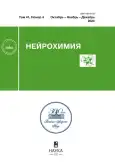Long-Term Memory: The Role of Light and Learning in Coping with Stress in Drosophila Melanogaster
- Authors: Tokmacheva E.V.1, Medvedeva A.V.1, Shchegolev B.F.1, Nikitina E.A.1,2, Savvateeva-Popova E.V.1
-
Affiliations:
- Pavlov Institute of Physiology of the Russian Academy of Sciences
- Herzen Russian State Pedagogical University
- Issue: Vol 41, No 4 (2024)
- Pages: 403-409
- Section: Articles
- URL: https://gynecology.orscience.ru/1027-8133/article/view/653873
- DOI: https://doi.org/10.31857/S1027813324040115
- EDN: https://elibrary.ru/EGFXLW
- ID: 653873
Cite item
Abstract
The formation of a conditional connection allows the organism to change its reactions to various environmental factors, combining and mobilizing the necessary internal adaptive processes. It is assumed that there are common mechanisms underlying the formation of adaptive processes – stress response and learning. To develop methods for non-invasive correction of nervous system pathologies at a model object of genetics – Drosophila, the relationship of adaptive mechanisms of the formation of a conditional connection and the development of a stressor reaction to the weakening of the Earth’s magnetic field in light: dark conditions was studied. The role of learning and lighting in overcoming stress in connection with the formation of long-term memory in the paradigm of conditioned courtship suppression was revealed. Within the framework of quantum dynamics of electronic and nuclear spins of transition states of radical molecules, the hypothesis of their participation in the formation of long-term memory is considered.
Keywords
Full Text
About the authors
E. V. Tokmacheva
Pavlov Institute of Physiology of the Russian Academy of Sciences
Email: 21074@mail.ru
Russian Federation, Saint Petersburg
A. V. Medvedeva
Pavlov Institute of Physiology of the Russian Academy of Sciences
Email: 21074@mail.ru
Russian Federation, Saint Petersburg
B. F. Shchegolev
Pavlov Institute of Physiology of the Russian Academy of Sciences
Email: 21074@mail.ru
Russian Federation, Saint Petersburg
E. A. Nikitina
Pavlov Institute of Physiology of the Russian Academy of Sciences; Herzen Russian State Pedagogical University
Author for correspondence.
Email: 21074@mail.ru
Russian Federation, Saint Petersburg; Saint Petersburg
E. V. Savvateeva-Popova
Pavlov Institute of Physiology of the Russian Academy of Sciences
Email: 21074@mail.ru
Russian Federation, Saint Petersburg
References
- Лобашев М.Е. // О направленном формировании свойств высшей нервной деятельности в онтогенезе. Труды I и II совещания “Вопросы физиологии сельскохозяйственных животных”. М.-Л., 1957, с. 33–39.
- Лобашев М.Е., Савватеев В.Б. // Физиология суточного ритма животных. М., Л.: Изд-во АН СССР, 1959. 259 с.
- Agrawal P., Houl J.H., Gunawardhana K.L., Liu T., Zhou J., Zoran M.J., Hardin P.E. // Сurr Biol. 2017. V. 16. P. 2431–2441.
- Karki N., Vergish S., Zoltovski B.D. // Protein Science. 2021. V. 30. № 8. P. 1521–1534.
- Thöni V., Oliva R., Mauracher D., Egg M. // Chronobiology International. 2021. V. 38. № 8. P. 1120–1134.
- Zatsepina O.G., Nikitina E.A., Shilova V.Y., Chuvakova L.N., Sorokina S., Vorontsova J.E., Tokmacheva E.V., Funikov S.Y., Rezvykh A.P., Evgen’ev M.B. // Cell Stress and Chaperones. 2021. V. 26. № 3. P. 575–594.
- Damulewicz M., Mazzotta G.M. // Front Physiol. 2020. V. 11. Art. 99.
- Никитина Е.А., Васильева С.А., Щеголев Б.Ф., Савватеева-Попова Е.В. // Журнал высшей нервной деятельности им. И.П. Павлова. 2022. Т. 72. № 6. С. 783–799.
- Solov’yov I.A., Domratcheva T., Schulten K. // Scientific Reports. 2014. V. 4. Art. 3845.
- Vasilieva S.A., Tokmacheva E.V., Medvedeva A.V., Ermilovа A.A., Nikitina E.A., Shchegolev B.F., Surma S.V., Savvateeva-Popova E.V. // Cell and Tissue Biology. 2020. V. 14. № 3. P. 178–189.
- Kamyshev N.G., Iliadi K.G., Bragina J.V. // Learning and Memory. 1999. V. 6. № 1. P. 1–20.
- Журавлев А.В., Никитина Е.А., Савватеева-Попова Е.В. // Успехи физиол. наук. 2015. Т. 46. № 1. С. 76–92.
- Redt-Clouet C., Trannoy S., Boulanger A., Tokmatcheva E., Savvateeva-Popova E., Parmentier M-L., Preat T., Dura J-M. // European Journal of Neuroscience. 2012. V. 35. Р. 1684–1691.
- Никитина Е.А., Журавлев А.В., Савватеева-Попова Е.В. // Интегративная физиология. 2021. Т. 2. № 1. С. 49–60.
- Никитина Е.А., Медведева А.В., Герасименко М.С., Проников В.С., Сурма С.В., Щеголев Б.Ф., Савватеева-Попова Е.В. // Журнал высшей нервной деятельности им. И.П. Павлова. 2017. T. 67. № 2. C. 246–256.
- Ortega-de San Luis C., Ryan T.J. // JBC Reviews. 2022. V. 298. № 101866. P. 1–23.
- Surma S.V., Belostotskaya G.B., Shchegolev B.F., Stefanov V.E. // Bioelectromagnetics. 2014. V. 35. P. 537–546.
- Stutzmann G.E., Mattson M.P. // Pharmacol Rev. 2011. V. 63. № 3. P. 700–727.
- Медведева А.В., Реброва А.В., Заломаева Е.С., Тураева С.К., Никитина Е.А., Токмачева Е.В., Васильева С.А., Щеголев Б.Ф., Савватеева-Попова Е.В. // Журнал эволюционной биохимии и физиологии. 2022. Т. 58. № 1. С. 34–42.
- Zhang B., Lu H., Xi W., Zhou X., Xu S., Zhang K., Jiang J., Li Y., Guo A. // Neuroscience Letters. 2004. V. 371. P. 190–195.
- Yu C-J., Gao Y., Willis C.L., Li P., Tiano J.P., Nakamura P.A., Hyde D.R., Li L. // Journal of Neuroscience Research. 2007. V. 85. P. 488–496.
- Dusik V., Senthilan P.R., Mentzel B., Hartlieb H., Wülbeck C., Yoshii T. et al. // PLoS Genet. 2014. V. 10. № 8. Art. e1004565.
- Inami S., Sato S., Kondo S., Tanimoto H., Kitamoto T., Sakai T. // Journal of Neuroscience. 2020. V. 40. № 7. P. 1427–1439.
- Yin J.C.P., Cui E., Hardin P.E., Zhou H. // Front Syst Neurosci. 2023. V. 17. Art. 1129152.
- Sarimov R.M., Serov D.A., Gudkov S.V. // Biology. 2023. V. 12. Art. 1513.
- Rodgers C.T., Hore, P.J. // Proceedings of the National Academy of Sciences of the United States of America. 2009. V. 106. P. 353–360.
- Abeyrathne C.D., Halgamuge M.N., Farrell P.M. // World Acad Sci Eng Tech. 2010. V. 64. P. 18‒23.
- Nair P.S., Zadeh-Haghighi H., Simon C. // Scientific Reports. 2024. V. 14. Art. 3628.
- Thoeni E.Y., Dimova Т., Kietzmann R.J., Usselman M. // Redox Biol. 2024. V. 72. Art. 103152.
- Karovetskaya D.M., Medvedeva A.V., Tokmacheva E.V., Vasilyeva S.A., Rebrova A.V., Nikitinа E.A., Shchegolev B.F., Savvateeva-Popova E.V. // Neurochemical Journal. 2024. V. 18. № 1. P. 36–46.
Supplementary files











